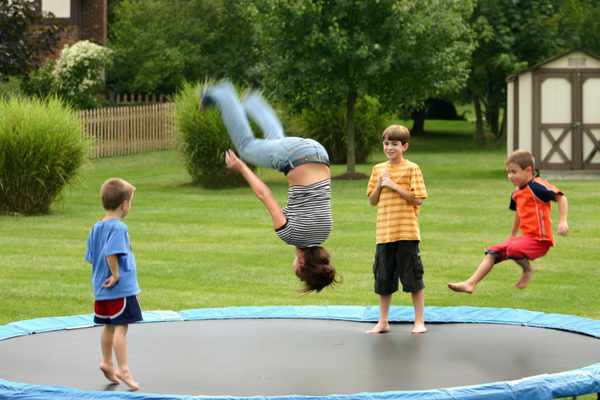
What’s The Recommended Age for Trampolines?
Buying a trampoline is an essential purchase that you cannot decide suddenly. The age of your children significantly determines the trampoline you purchase. As a parent, all you want is to ensure that your children are safe when they begin bouncing on the trampoline. With that in mind, we will look at the recommended age for trampoline use and how that impacts your next purchase. So, in this article, we will look at the right trampoline age and the best-suited trampolines for your kids at different periods.
Age for trampoline use

Children under the age of 6 years are lighter and have little coordination to assist them to control how they land on the trampolines, so they have a high risk of fractures. Their bones are still developing, and the pressure they put on themselves when using the trampoline puts them at risk. Rospa (The Royal Society for the Prevention of Accidents) says that children below the age of 6 years should not be allowed to use trampolines with a diameter of more than 10 feet or 20 inches high.
Trampoline bouncing poses a significant risk of injury for young children. Jumping can result in fractures and sprains in the legs or arms as well as possibly severe neck and head injuries. Due to the high risk of injury, the American Academy of Pediatrics firmly discourages using trampolines at home. However, trampoline park injuries are an area of significant concern as well.
Although it is hard to resist childish pleas, more than two-thirds of trampoline injuries occur when there is more than one user on the trampoline. The lightest child is five times more prone to injuries than anyone else. Therefore, you should only allow one child at a time.
Are trampolines safe for 2-year-olds?
A recent study has shown that many recreational facilities encourage the use of trampolines for small children, despite recommendations by health professionals and organizations not to allow kids under the age of 6 years to use them.
Again, the American Academy of Pediatrics advises against the use of trampolines for all kids, saying that padding and enclosures may not prevent the kids from all injuries and may give a false sense of security. Nevertheless, if you allow your children to use them, this group recommends active adult supervision, avoiding flips and somersaults and restricting the use of trampolines to a single user at a time.
According to Armin Tehrany, the founder of Manhattan Orthopedic Care who is also an orthopedic surgeon, toddlers are especially prone to trampoline injuries. The bones of these toddlers are still developing, and the soft surface does not ensure safety since the mechanism of bouncing on a trampoline progressively to higher heights and then landing puts lots of pressure on the developing bones.
This pressure the children put themselves makes them prone to fractures and other serious injuries. As the trampoline parks rise in popularity, so are the injuries in these recreational facilities. According to a recent Pediatrics study published in 2017, emergency department visits for injuries that occur in trampoline parks rose from 581 cases in 2010 to around 6932 in 2014. That is more than a ten-fold growth.
Are mini trampolines safe for toddlers?
Mini trampolines, at times, referred to as rebounders are popular among adults. They are usually used to enhance fitness and general health, but kids may be attracted to these small-sized trampolines since bouncing up and down is entirely fun.
However, they can be dangerous for kids. AAP (American Academy of Pediatrics) says that the dangers of all sizes of trampolines outweigh any real benefits for young kids. If you allow your child to bounce on adult mini trampolines, it is important to have safety practices in mind.
American Academy of pediatrics trampoline

Trampolines are common among parents and kids offering fun and great exercise with easy supervision. However, at times fun can cost you, leading to injuries associated with the use of trampolines. While most trampolines are created to be child-friendly, accidents mostly happen when the kids land in a wrong manner. They can occur when flipping or jumping, while knocked by another jumper or land on the frame or springs of the trampoline.
According to a recent report released by American Academy of Pediatrics, home trampolines are not safe for children. A report updated in 2014 by the American Academy of Orthopedic Surgeons, there were over 286,000 kids treated for trampoline-related injuries, and around 104,691 of those cases were emergency department visits. Furthermore, the rate of trampoline-related injuries is more common in kids than in adults. Due to this AAP advises that both full-sized and mini trampolines should not be used at homes. They should only be utilized in supervised training plans for diving, gymnastics and other competitive sports. However, only one jumper should be allowed on the trampoline at any single moment.
Recommended trampoline for 4-year-old
For most parents, safety is among the most significant aspects of a child's trampoline. Next, you can consider things like fun, price, durability and other factors. While there is no perfect trampoline, some of them rank quite well in most of the crucial areas. Your trampoline does not have to be costly to be good quality.
One of the recommended trampolines for the 4-year-olds is the Sportspower My First Trampoline. It is a heavyweight mini trampoline that comes with foam outer edge, and it is ideal for kids aged more than three years. This trampoline promotes a healthy lifestyle by offering an exciting way for your kid to improve the heart rate, enhance flexibility, and also work their muscles. Check the latest price here >>
This trampoline encourages safe bouncing with soft foam padded borders and low design. It is also durable and versatile, and it is intended for outdoor use. It also comes with a safety net to ensure that your children do not fall off when using the trampoline.
Recommended trampoline for 8-year-old
Zupapa 12 Ft TUV Approved Trampoline is the recommended take home safe trampoline for children aged eight years and above. It is a heavy-duty trampoline that is made up of galvanized springs that provide your children with superior jumps. Its jumping mat is made from a UV protection polypropylene which is heavy duty for durability and strength. Check latest price on Amazon >>
The thick foam pad protects your children from injuries, and it's more durable and has a longer service life. The trampoline comes with all the accessories needed for bouncing. They include a safety enclosure, a heavyweight galvanized steel ladder, as well as a rain cover. It is easy to assemble, and it doesn't require any drilling.
The Bottom Line
It is quite clear that a trampoline provides the entire family with lots of fun, but there are risks associated with them. To ensure the safety of the users, ensure you understand the recommended age for trampoline use to avoid putting young children in danger. You can also observe safety precautions when using a trampoline to prevent the kids from hurting themselves. Remember that the American Academy of Pediatrics recommends that the trampoline age should not be less than 6 years.



